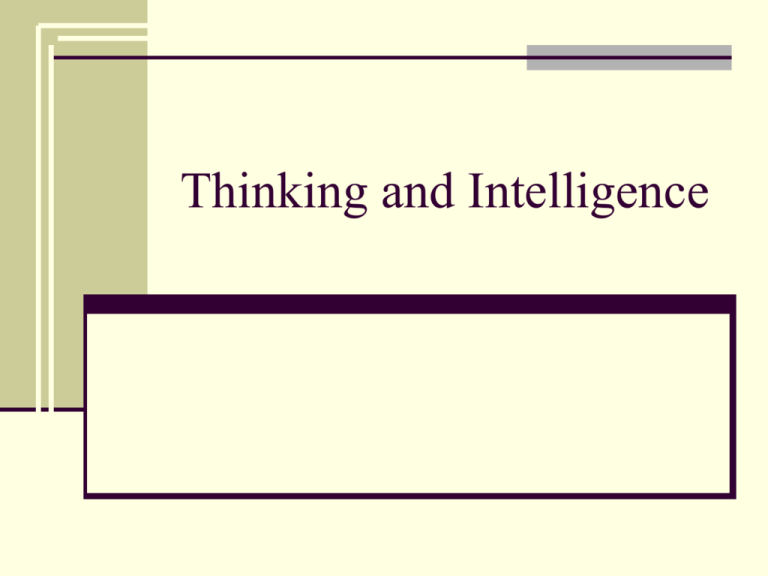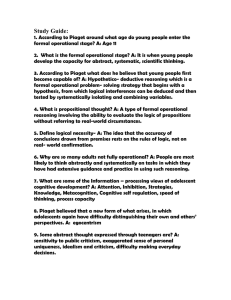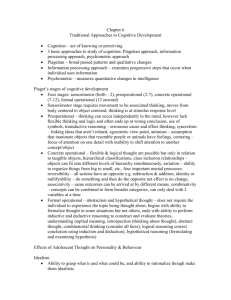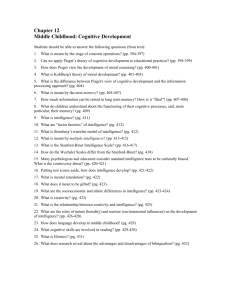What is Psychology? - Weber State University
advertisement

Thinking and Intelligence Piaget’s Theory Intelligence is a basic life function that helps the organism adapt to its environment. Intelligence is “a form of equilibrium toward which all cognitive structures tend” (1950 pg 6) All intellectual activity is undertaken with one goal in mind: to produce a balanced, or harmonious, relationship between one’s thought process and the environment – cognitive equilibrium Interactionist or Constructivist model (we are not passive participants rather we act on novel objects and events to gain understanding) Piaget: Structure of Intelligence Schemes- models, or mental structures, that we create to represent, organize, and interpret our experiences Similar to the layperson strategy or concept Three Types of Schemes Behavioral- organized pattern of behavior that are used to represent and respond to objects and experiences (ball is an object that bounces and can be bounced and rolled Symbolic- internal mental symbols that one uses to represent aspects of experience Operational (cognitive operation)- an internal activity that a person performs to reach a logical conclusion (example in mathmatical symbols) Piaget’s Theory: Cognitive Development: Cognitive development consists of mental adaptations to new observations and experiences Adaptation- the process of adjusting to the demands of the environment Adaptation takes two forms: Assimilation: Absorbing new information into existing cognitive structures. Accommodation: Modifying existing cognitive structures in response to experience and new information. Piaget: Four Stages of Development Sensorimotor (birth to 2) Infants coordinate their sensory inputs and motor capabilities, forming behavioral schemes that permit them to act on and get to know their environment. Object Permanence Preoperational (ages 2-7) (Pre) operational Egocentrism Conservation (recognition that the properties of an object do not change when its appearance is altered in some superficial way Increase their use of mental symbols(symbolic/ pretend play “Conservation of Liquid” Task Conservation of Substance and Number Conservation of Substance Two identical balls of clay One is deformed “Do the two pieces have the same amount of clay?” Conservation of Number Two identical rows of blocks One row is rearranged “Do the two rows have the same number of blocks? Piaget: Four Stages of Development Concrete Operational Acquisition of cognitive operations and thinking more logically about real objects and experiences Conservation (reversibility; clay) Awareness of divergent perspectives Formal Operational Acquisition of more thinking more rationally and systematically about abstract concepts and hypothetical events 2X + 5 = 15 (Hypothetical problem which can only be answered by abstract reasoning using a symbol system. Thinking Like a Scientist Evaluating Piaget’s Theory Stage changes are neither as clear-cut nor as sweeping as Piaget believed. Children sometimes understand more than Piaget believed. Preschoolers are not as egocentric as Piaget thought. Cognitive development depends on the child’s education and culture Piaget overestimated the cognitive skills of many adults. The Elements of Cognition Concept: Mental category that groups objects, relations, activities, abstractions, or qualities having common properties. Proposition: A unit of meaning that is made up of concepts and expresses a single idea. Mental Image: Representation that mirrors or resembles the thing it represents. Cognitive Schema: An integrated mental network of knowledge, beliefs, and expectations concerning a particular topic or aspect of the world. How Conscious is Thought? Subconscious Processes: Mental processes occurring outside of conscious awareness but accessible to consciousness when necessary. Automaticity- automatic routines performed without thinking Helpful and Harmful Nonconscious Processes: Mental processes occurring outside of and not available to conscious awareness. “Aha!” Implicit Learning- learning without an awareness of how you did so and without being able to state exactly what it is you have learned Mindlessness- obliviousness to the present context Reasoning Rationally Reasoning Rationally: Formal Reasoning Reasoning- purposeful mental activity that involves operating on information to draw conclusions or inferences from observations, facts, or assumptions Formal Reasoning: Algorithms Logic Deductive- A tool of formal logic in which a conclusion necessarily follows from a set of observations or propositions (premises). Inductive- A tool of formal logic in which a conclusion probably follows from a set of observations or propositions or premises, but could be false. Reasoning Rationally: Informal Reasoning Heuristic: A rule of thumb that suggests a course of action or guides problem solving but does not guarantee an optimal solution. Dialectical Reasoning: A process in which opposing facts or ideas are weighed and compared, with a view to determining the best solution or resolving differences. Pro vs Con Reflective Judement Synonymous with Critical Thinking Three Stages Pre-reflective Judgment Quasi-reflective Judgment Reflective Judgment Barriers to Reasoning Rationally Barriers to Reasoning Rationally Exaggerating the Improbable Avoiding Loss The Confirmation Bias Biases Due to Mental Sets The Hindsight Bias The Need for Cognitive Consistency Overcoming Our Cognitive Biases Exaggerating the Improbable Availability Heuristic: The tendency to judge the probability of an event by how easy it is to think of examples or instances. For example, most people overestimate the odds of dying in a plane crash. Dying in an automobile accident is far more likely. Avoiding Loss People try to minimize risks and losses when making decisions. Responses to the same choice will differ based on whether outcome is framed as gain or loss. In the example, outcomes are the same in Problems 1 and 2. The Confirmation Bias Confirmation Bias: The tendency to look for or pay attention only to information that confirms one’s own beliefs. E J 6 7 Test this rule: If a card has a vowel on one side, it has an even number on the other side. Which 2 cards to turn over? Biases Due to Mental Sets Mental Set: A tendency to solve problems using procedures that worked before on similar problems. Mental sets help us solve most problems efficiently. Not helpful when a problem calls for fresh insights or a new approach. The Nine-Dot Problem Connect all 9 dots Use only 4 lines Do not lift your pencil from the page after you begin drawing The Hindsight Bias Hindsight Bias: The tendency to overestimate one’s ability to have predicted an event once the outcome is known. Also known as the “I knew it all along” phenomenon. “The older they get the better they were when they were younger.” (Jim Bouton, professional baseball player) Need for Cognitive Consistency Cognitive Dissonance: A state of tension that occurs when a person simultaneously holds two cognitions that are psychologically inconsistent, or when a person’s belief is inconsistent with his or her behavior. Likely to Reduce When: Choice Made Freely Justify Behavior that Conflicts with Views of Self Justification of Effort Intelligence Intelligence Intelligence: An inferred characteristic of an individual, usually defined as the ability to profit from experience, acquire knowledge, think abstractly, act purposefully, or adapt to changes in the environment. g factor: A general intellectual ability assumed by many theorists to underlie specific mental abilities and talents. The Psychometric Approach IQ scores are distributed “normally” Bell-shaped curve Very high and low scores are rare 68% of people between 99.7% between have IQ 85-115 55-145 The Cognitive Approach Metacognition: The knowledge or awareness of one’s own cognitive processes. Tacit Knowledge: Strategies for success that are not explicitly taught but that instead must be inferred. Sternberg's Triarchic Theory Components - a.k.a. “Analytic” Comparing, analyzing, and evaluating. This type of processes correlates best with IQ. Experiential - a.k.a. “Creative” Inventing or designing solutions to new problems. Transfer skills to new situations. Contextual - a.k.a. “Practical” Using (i.e., applying) the things you know in everyday contexts. The Origins of Intelligence The Origins of Intelligence Genes and Intelligence The Environment and Intelligence Attitudes, Motivation, and Intellectual Success Correlations in Siblings’ IQ Scores IQ scores of siblings were highly correlated, even when they were reared apart. Identical twins have higher correlations than fraternal twins. Suggests a genetic link Explaining Group Differences Within a group with all treated exactly the same, differences may reflect genetics. When one group differs from another, the differences may reflect environmental differences. Environment and Intelligence Factors associated with reduced IQ: Poor prenatal care Malnutrition Exposure to toxins Stressful family circumstances Healthy and stimulating environments can raise IQ, sometimes dramatically.







